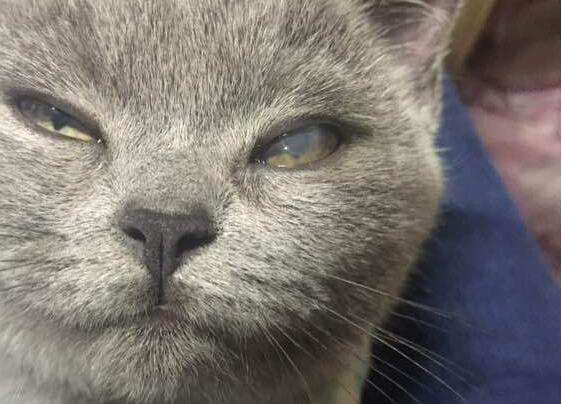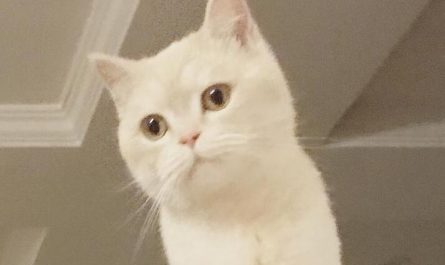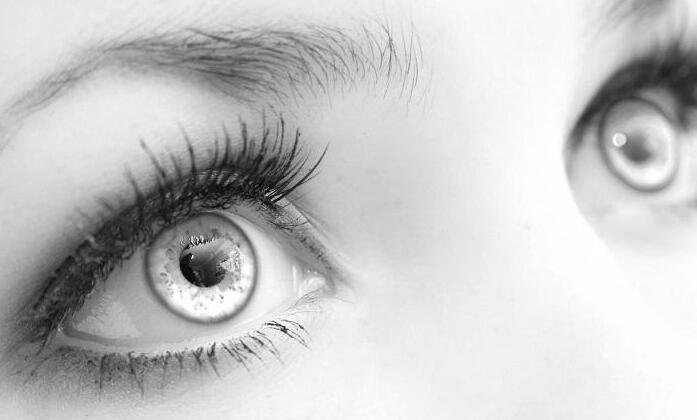Causes of keratitis in cats
Infectious cause
Feline Herpes Virus-1 (FHV-1): This pathogen is extremely common in cats, and more than 80% of cats may have latent infection, so it is the most common cause of conjunctivitis in cats of all ages. This virus is spread by inhalation or direct contact, and kittens are often infected by female cats early in their lives. FHV-1 can infect epithelial cells in the conjunctiva and upper respiratory tract, and occasionally infect the corneal epithelium, causing these cells to die. The initial clinical symptoms after infection are mainly conjunctivitis alone, or appear simultaneously with upper respiratory tract symptoms. The clinical form of this disease typically lasts for 10 to 14 days, but in kittens, more severe cases can lead to conjunctival ulcers, which can adhere to itself or to the cornea. Recurrent conjunctivitis is caused by the recurrence of viral infection, and some cats can also be caused by stress.
Cat Chlamydia: It is a compulsory intracellular microorganism that can infect conjunctival epithelial cells and cause conjunctivitis. The infection is spread through inhalation of polluted air, direct contact and pollutants. If the infection is not treated in time, chronic infection can occur, or asymptomatic carrier status can occur. Although extremely rare, the spread of feline chlamydia from cats to humans also occurs, so you should wash your hands promptly after treating infected cats.
Mycoplasma felis: It is also a compulsory intracellular microorganism, which can act as a secondary invading pathogen of the main pathogen such as FHV-1 or Chlamydia feline.
Calicivirus: Compared with FHV-1, this virus causes milder conjunctivitis. Calicivirus infects the respiratory tract and can also cause oral ulcers and multiple arthritis.
Non-infectious causes
Eosinophilic conjunctivitis and keratitis: Eosinophilic inflammation of the conjunctiva can occur simultaneously with eosinophilic keratitis or as a major disease.
Corneal rot: This condition is relatively common in cats, especially in Persian and Himalayan cats. Corneal rot is usually caused by chronic irritation, such as chronic corneal ulcer, FHV-1 keratitis, or eyelid inversion and trichiasis. Corruption is the obvious brown to black area of corneal degeneration, which can account for more than 50% of the cornea.
Immune-mediated diseases: External antigens such as pollen can cause type I allergic reactions. This is the most common bilateral disease and may be accompanied by upper respiratory tract diseases. Conjunctivitis can appear as part of the clinical symptoms during food allergies. Autoimmune diseases can also be complicated by conjunctivitis, but conjunctivitis is not the only clinical symptom. Autoimmune diseases can also cause unilateral or bilateral keratitis.
Foreign body irritation: chemical substances sprayed or rubbed on the cat’s face can cause irritation to the conjunctiva and cornea. Insect bites around the eyes can cause conjunctivitis, but rarely cause keratitis.
Keratoconjunctivitis: Dry eye is not common in cats, but it is reported to occur as a disease without predisposing factors, and it can also occur as a sequelae of FHV-1 infection in young cats.
Coat abnormalities: chronic inflammation caused by double eyelashes, trichiasis, or ectopic eyelashes is not common in cats, but it has also been reported.
Symptoms and treatment of cat eye inflammation
1. Neonatal ophthalmia
There are many tears, the outlet of tears is abnormal or the eyelids turn inward, the eyelashes stimulate the cornea, and the eyelids turn out to cause tearing and excessive excrement. Lacrimia usually occurs when there is excessive tearing and abnormal lacrimal glands. Persian cats with small noses and small faces sometimes get this disease. This disease has a lot to do with the shape of the eyes and nose.
2. Conjunctivitis and keratitis, etc.
Conjunctivitis
The thin film above the white eyeball is called conjunctiva. Conjunctivitis is a common disease. Cats who live in newly renovated houses and households with poor indoor hygiene often have this disease.
Causes: due to bacterial and viral infections, trauma, allergies, drug or plant stimulation, garbage, dust, etc.
Symptoms: feces, blinking, tearing, and nictitating membrane exposed. In severe cases, it can also cause swelling of the conjunctiva. There are symptoms of feline viral rhinotracheitis, feline cold infection and other diseases.
Medical Handbook: If the disease that causes conjunctivitis is more serious, it must be treated first. Remove the dirt around the eyes and prescribe eye drops from the hospital. When there is a tendency to scratch your eyes, use an Elizabethan collar to prevent it. Remove pet eye drops, and look at the last of eye drops available in pharmacies.
Keratitis
Some friends think that keratitis and conjunctivitis are the same thing, but they are not. The conjunctiva is the surface layer of the white part of the eye, and the cornea is the transparent tissue in front of the eyeball. Because the cornea is in direct contact with the outside world, there are more chances of being infected. Cats with vitamin A deficiency and malnutrition often develop corneal softening.
Causes: Random eyelashes, trauma, inverted eyelids or conjunctivitis can cause corneal inflammation.
Symptoms: Eye pain, watery eyes, turbid and whitish cornea (but not the same as cataract).
Medical manual: The general practice is to apply a warm towel on the cat’s eyelids, which can promote blood circulation, and then use some antibiotic ointments prescribed by a pet doctor for treatment.
Ectorrhea
Just by looking at the name, it must be a disease related to tears. The corners of some cats’ eyes are always wet, as if tears are streaming out. Tearing refers to a lot of tears, such as the phenomenon of excessive tears when crying or eye inflammation; while tearing refers to an abnormal tearing phenomenon. This eye disease may be related to eye allergies or respiratory infections, and it often occurs in cats with genetic short faces such as Persians and Exotics. Therefore, the owners of these cats must remember to wipe their eyes every day.
Causes: excessive secretion of tears or blocked tear ducts.
Symptoms: The hair under the cat’s eyes is stained dark brown.
Medical Handbook: Do not use eye ointment or eye drops for cats casually. Be sure to ask a professional doctor to prescribe eye drops.
cataract
Speaking of this disease, it is necessary to mention the elders among cats, because cataracts generally appear in older cats. If the cat is older and has diabetes, the chance of it getting cataracts is very high. It doesn’t mean that the white misty stuff in the eyes has a cataract. The spots on the surface of the lens of an elderly cat are not necessarily a cataract. It may only be caused by the change in the refractive index of the lens in old age and does not affect the vision. .
Cause: The lens becomes white and opaque due to congenital or acquired causes.
Symptoms: Cat eyes become white and opaque.
Medical Handbook: The common treatment for cataracts is to perform surgical operations to remove the opaque parts so that the cat can restore vision. Only experienced doctors can perform this kind of surgery. If there is no way to perform the operation or the operation fails, the cat’s eyesight will gradually lose.
glaucoma
Many people have heard of this disease, but cats are also troubled by this disease.
Cause: The cause of glaucoma is the increase in the anterior aqueous humor between the cornea and the lens, causing the pressure in the eye to increase. In addition, if the cat’s eyes bleed internally, or the eye fluid cannot circulate due to various reasons, it can also cause glaucoma.
Symptoms: swollen eyes, turbid cornea, etc.
Medical manual: There are medical treatments for glaucoma, such as eye medicine, etc., but it depends on the severity of glaucoma. If in addition to high intraocular pressure, eye infection or even pus has been complicated, surgery is a quicker solution .
3. Turned eyelids
Inverted eyelids are uncommon. The cause of the disease is more common in the lower eyelid structure of the outer corner of the eye. The cause of inversion stimulates the eyeball, and the spasm of the eyelid muscle causes more serious tearing, corneal damage, and eyelid inversion. Surgery is an effective way to correct inverted eyelids.
4. Eyelid ectropion
Cat’s eyelid ectropion is caused by cat bites, traffic accidents and other traumas. Some parents believe that there is no major problem with cat eyelid ectropion, and these symptoms can be observed from the appearance. When it is found that the pet cat has ectropion of the eyelids, it is recommended to take it to the pet hospital for examination in time. With the help of the veterinarian, prescribe some medicines such as eye drops to wipe the cat.
treatment method
Mild bacterial inflammation generally includes red and swollen eyes, mucus-like secretions in the eyes, and eyes closed with secretions. If you don’t wipe the dirty cat’s eyes for a few days, let the secretions paste the eyes until they are clean. Sometimes pus will come out of the eyes, it doesn’t matter, don’t worry, the inflammation of the cat’s eyes is normal and it is easy to treat it by yourself. First clean up the secretions, and then remove the chloramphenicol eye drops, 3 to 5 times a day, one or two drops each time, stick to two or three days will definitely get better.






